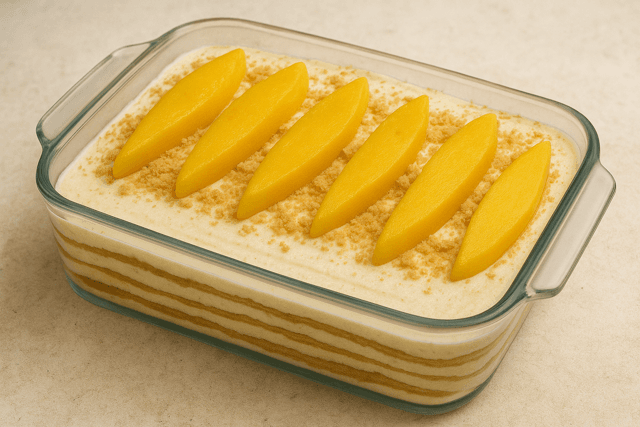Mango Float: The Cool Filipino Classic That Requires Zero Baking

Mango Float: The Cool Filipino Classic That Requires Zero Baking
Next up in our 80 Bakes series, we land in the Philippines with a dessert that’s as easy to make as it is hard to stop eating: mango float.
This fridge-friendly, no-bake dessert layers fresh mango slices, whipped cream, sweetened condensed milk, and Graham crackers. But mango float didn’t always exist in this simple form. Its story starts further back—with a fancier, fussier ancestor.
From Crema de Fruta to Mango Float
To trace mango float’s origin, we need to look at a dessert called crema de fruta. Brought to the Philippines during Spanish colonization, crema de fruta was a holiday staple: a multilayered cake made with sponge cake, custard, canned fruit cocktail, and gelatin. It was delicious—but time-consuming. It required baking, boiling, and layering with care.
As the 20th century wore on, Filipino home cooks began to improvise. Not everyone had access to ovens or time for elaborate preparations. So they simplified.
The sponge cake was swapped for store-bought Graham crackers. The custard was replaced with an easy combo of whipped cream and sweetened condensed milk. And instead of generic fruit cocktail, they used something far better: local mangoes—specifically, the rich, buttery-sweet carabao mangoes the Philippines is famous for.
The result? A chilled dessert with all the layered appeal of crema de fruta, but none of the complexity.
A Dessert of the Times
Mango float didn’t have a single inventor or date of creation. It spread through kitchens and family gatherings in the 1980s and 1990s—an era when refrigerators were becoming common household appliances, and ingredients like canned milk and Graham crackers were widely available in supermarkets.
It was the perfect mix of convenience and culture. It didn’t need baking. It was adaptable. It was cold—ideal for the Philippines’ tropical heat. And it turned a good mango into something that felt indulgent.
The Filipino Fridge Cake
Sometimes called mango refrigerator cake, mango float has become a go-to for parties, potlucks, birthdays, and “just because.” You’ll see variations everywhere—some use other fruits, add crushed nuts, or sprinkle in chocolate. But the basic concept stays the same: layer, chill, and serve cold.
It’s no accident that mango float became so popular. It’s comfort food designed for the modern Filipino home. And like many great dishes, it grew out of adaptation—making do with what’s on hand, then making it better.
Craving a slice? Check out the full mango float recipe in our Recipes section and make it yourself—no oven needed!
Coming Up Next in 80 Bakes
After a chill dessert in the tropics, we’re heading north. Next in our 80 Bakes series: brunsviger from Denmark—a sticky coffee cake soaked in brown sugar butter, perfect for sharing and fika breaks. Less cream, more caramel. Stay tuned.
Share your thoughts
Did you find this history article interesting? Rate it below and let others know!